Landscapes can involve many directional changes in the pictorial elements. The horizon exist as a key element in most outdoor scenes whether it’s a landscape, seascape or cityscape. But directional changes can happen with some building design, vegetation, trees—changes that add gestural components in your composition.
How To Use
Landscapes

The shoreline is a dynamic element in this seascape since most picture elements are horizontal or vertical.
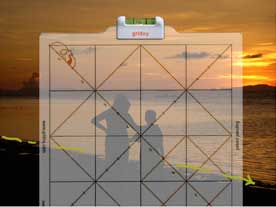
With the gridvu in place, the angle of the shoreline is easy to gauge.
Figures & Portraits
Correct proportion is a constant issue when dealing with figures. The head is a common unit of measurement to estimate the length of the body as well as other parts. For instance the foot is typically as long as the head, and the hand is often the distance from the chin to the hairline. These are simple guidelines that can bring the artist closer to a natural treatment of the human figure. The half skull icon on the diagonal bar of the gridvu can provide a quick reading of the figure for most poses. The usual practice of counting the number of head lengths by sighting the figure with the thumb on a pencil or pen is prone to miscalculation because it requires positioning the measuring tool at the exact spot where the last count ended. As the arm comes down to make the count, the arm moves in an arc making the reading somewhat distorted. By sighting through the gridvu the reading is immediate once the skull icon matches the length of the head, and the length of the figure is noted, whether the pose is standing or seated. Furthermore, the centering feature of the gridvu can be used to verify proportional concerns. There are some poses where the head might not be visible, or in some reclining poses. In this instance the centering marks on the gridvu coupled with a reading of the width to height ratio can give the artist better control of the pose. For portraits, specially where the intent is to capture a good likeness, the distances between facial features are key concerns. Additional reference lines on the lower right quadrant of the gridvu is intended to provide a degree of accuracy in locating facial features.

Viewed through the gridvu view, the total length of this seated child is just over 3.5 heads.
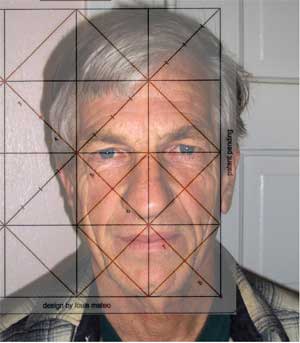
The size of the model’s face consist of 2 quarters of gridvu’s reference lines. In this instance, the eyes are located exactly halfway from the top of the head to the tip of the chin. Vertical, horizontal, and diagonal lines, plus the shapes they create give a better idea of the distances between the facial features.
Fitting the subject to your working space
In some instances the artist wants to tailor a particular subject to fit a certain format. For a variety of reasons, a canvas might be on the long side to fill a narrow horizontal or vertical space. Muralists may have a certain wall to work on that has a specific width-to-height ratio. The gridvu makes it possible to make working drawings on a format that has the exact ratio of a wall or canvas. As a sighting device for outdoor scenes, or still life subjects, masking tape may be used to create a ‘window’ on the gridvu that has been matched to a particular working surface. The masking tape window can now act like a viewfinder that has the same format as the working surface.
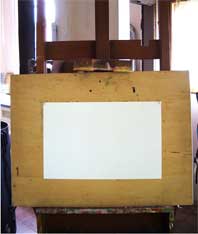
I have a drawing sheet I want to use for a street scene. The size of the paper is 13″ x 20″.
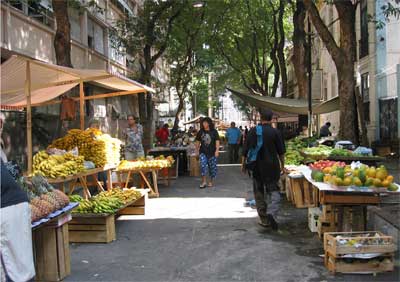
This is the scene I want to work from but I want to compose a scene that will fit the format of my paper. Place masking tape on the other side of the grid markings to prevent the tape from distressing the grid.
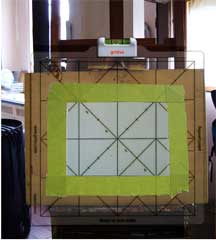
Sighting my work space and using masking tape on the gridvu, I’ve created a window on the gridvu that will match the format of my drawing sheet.
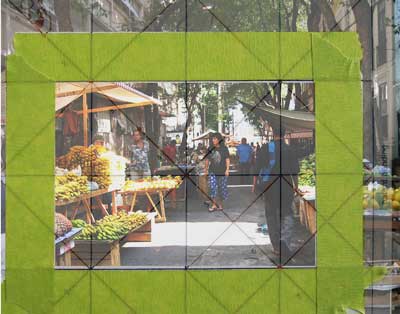
With the taped gridvu, I scan a few composition possibilities and decide to work on this portion of the scene knowing it is already “sized” to my drawing sheet.
How to care for your gridvu
Keep your gridvu clean by replacing it in the sleeve when not in use. Do not use solvents although a dab of plastic polish or cleaner can be used. Apply with a soft rag and wipe until dry. A mild soapy cloth also works. When using masking tape as a reference frame, use on the other side of the plate to avoid distressing the grid markings.
